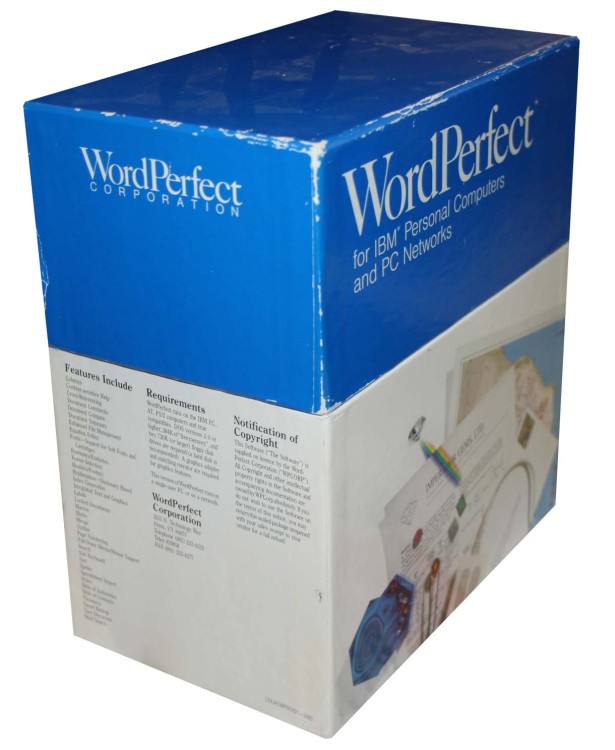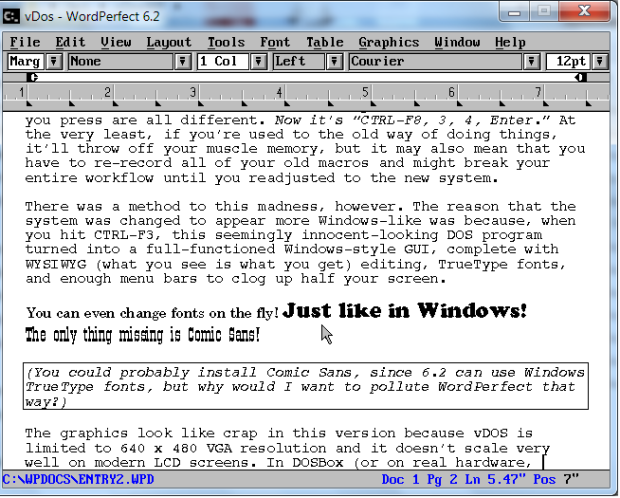 WordPerfect
WordPerfect
WordPerfect
The most prolific word processor for DOS during the 1980s and early 90s was WordPerfect. It started life as a university development at Brigham Young University for use on a Data General minicomputer for the City of Orem, UT. in 1979. Bruce Bastian was a BYU graduate who worked with his Computer Science professor Alan Ashton on the project. Ashton had spent the summer of 1977 writing the specifications for a word processing package, having seen a Wang standalone word processing system and wanted to build a system that eliminated the need to print a document just to see what it would look like (most word processing systems displayed formatting characters, line feeds, page feeds, centering, tabs, etc. all on the screen embedded into the text). Once the product was in use, the two retained the rights to the software, and together with Don Owens formed Satellite Software International (SSI) in September 1979, to sell it under the name "SSI*WP" in 1980. It sold for $5,500 per copy. Relying on word-of-mouth marketing, their word processor was pitched at other Data General users. SSI*WP was very different to the then popular Wang standard for word processing. Bruce and Alan believed the screen should not be cluttered with control codes and key sequences, instead just having a blank 'page' you could start typing on.
WordPerfect 2.20 (1982)
It was ported to MS-DOS the day after Thanksgiving, 1982. Sold as WordPerfect 2.20, it went out to a total user base of around 600. It featured a 30,000-word dictionary, support for newspaper-style columns, and proportional spacing, as well as automatic footnotes, a four-function math package, and a built-in print spooler. SSI's 1982 sales were a modest $1M.
Several minor releases quickly followed in the coming months into 1983, including versions 2.21, 2.23 and 2.24, apparently changed only by the addition of more printer drivers and to correct bugs. This added to the growing belief that SSI was producing poor-quality software. They decided to stop updating the release numbers on the box, instead just updating the release date stamped on it. Compared to MicroPro's WordStar, its closest rival and industry forerunner in 1983, WordPerfect was incredibly feature-rich. They got their big break in Spring 1983 when ComputerLand, the largest chain of computer retail stores in North America, agreed to stock WordPerfect. At this time, WP was listed as the fifth best-selling word processing program, behind WordStar, Word Plus, MultiMate and PFS:Write.
WordPerfect 3.0 (1983)
WordPerfect 3.0 was released for DOS in October 1983 at Comdex for the price of $495, featuring one- and two-keystroke commands, a keyboard overlay, an automatic insert mode, and the ability to have documents printed as they appeared on the screen. This version was fully updated to support DOS 2.x, being able to use subdirectories and hard disks. It also provided a solution to the problem of printer support - WordPerfect 2.x only supported Epson and Diablo printers which were hard-coded in the main application's executable. With v3.0 the company came up with the concept of printer drivers, which essentially amounted to a file containing a list of control codes for each particular model of printer. Thus, version 3.0 of WordPerfect had support for 50 different printers, and within a year, this was expanded to 100. WordPerfect also supplied an editor utility that allowed users to make their own printer drivers or modify the included ones. Slightly before the release of version 3.0, SSI also launched Personal WordPerfect in June 1983, a functionally-reduced version of 2.2x which was designed for non-business use and cost just $195. This version catered for user-defined margins, page lengths and spacing. The company closed 1983 with a record annual revenue figure of $3.5 million.
WordPerfect 4.0 (1984)
In November 1984, WordPerfect 4.0 was released at Comdex - the same show in which MicroPro launched WordStar 2000. Advertising of this version had been stepped up, and gave the impression the product was much improved, whilst in reality only minor changes had been made over 3.0. It did come with a better manual (in colour this time), a tutorial, and user exercises. By the end of 1984, WordPerfect was the number three word processing software, trailing behind Multimate (a Wang lookalike program), and WordStar, which was in decline. Their headcount had risen from 47 to 84 employees this year, but as SSI had begun releasing other non-word processing software including its first spreadsheet, Math Plan 1.0, and SSI*Data, these were not selling well.
WordPerfect 4.1 came out in October 1985 as well as a reduced version released as Personal WordPerfect 4.1.
WordPerfect 4.2 (1986)
WordPerfect 4.2 arrived in October 1986 which at this time made WordPerfect the world's best-selling word processing software, capturing almost 1/3rd of the entire IBM-compatible word processing market, and made the company the fifth largest independent personal computer software company. In May of this year, SSI had changed its name to WordPerfect Corporation. By the end of 1986, the company's annual revenue had his $52M. This version [4.2] added automatic line numbering (important to law offices), and automatic numbering and placement of footnotes and endnotes (again, important to law offices and academics). It also added a document summary, an index concordance for phrases, and up to 24 columns per page. You could also drop into DOS to perform commands while the program was open. WordPerfect 4.2 became the first program to overtake WordStar, the original market leader, in a major application category on the DOS platform. WordPerfect 4.2 provided only the text enhancements of Bold and Italic. Two interim releases of 4.2 came out in May 1987 and July 1987, as well as a faster version that came out in September 1987.
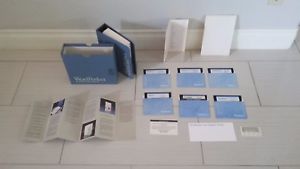
Business software in the 1980s and early 1990s always came in a very large box, complete with one or more heavy manuals!
In 1987, WordPerfect Corp. launched an integrated product called WordPerfect Executive, designed for laptop users. This incorporated a word processor, spreadsheet, calendar, and information management program. Adding to their non-word processing product lineup, they also launched Repeat Performance which helped improve the speed of programs and cursor movement, and PlanPerfect - an advanced and faster version of Math Plan. This year, WordPerfect's employee headcount had risen to 350, including 100 technicians working in customer support. Alan Ashton left BYU to work full-time at WordPerfect Corporation as its president. He soon began directing WordPerfect's international division, which was responsible for translating their software and manuals into 12 languages. At the end of 1987, WordPerfect Corporation had chalked up $100M in sales that year.
WordPerfect 5.0 (1988)
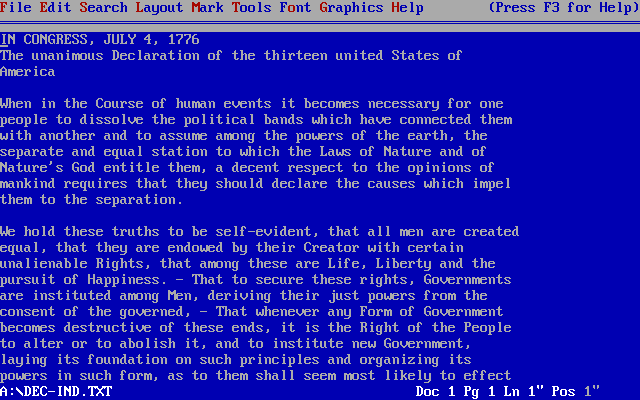 Version 5.0 was launched in May 1988 which added support for styles and style libraries. Numerous interim releases of 5.0 came out throughout 1988 and 1989, with a typical retail price of $495. The company was very busy around this time, working on DataPerfect 2.0 for DOS, WordPerfect Library 2.0 for DOS, and porting WordPerfect 4.2 to run on the Macintosh, VAX, SCO Xenix, OS/2, Microport Unix, DEC Ultrix, IBM 370, AIX, and many more.
Version 5.0 was launched in May 1988 which added support for styles and style libraries. Numerous interim releases of 5.0 came out throughout 1988 and 1989, with a typical retail price of $495. The company was very busy around this time, working on DataPerfect 2.0 for DOS, WordPerfect Library 2.0 for DOS, and porting WordPerfect 4.2 to run on the Macintosh, VAX, SCO Xenix, OS/2, Microport Unix, DEC Ultrix, IBM 370, AIX, and many more.
On 6th November 1989 WordPerfect released what would be their most successful version - WordPerfect 5.1 for DOS, selling for $495 in the U.S. This was the first version to support Macintosh-style text-based pull down menus to supplement the traditional function key shortcuts and mouse support. It also added support for tables (a spreadsheet-like feature), and full typesetting options (italic, redline, strikeout, etc) permitted by laser printers. Also included was a 'print preview' which provided a non-editable graphical representation of the final printed output.
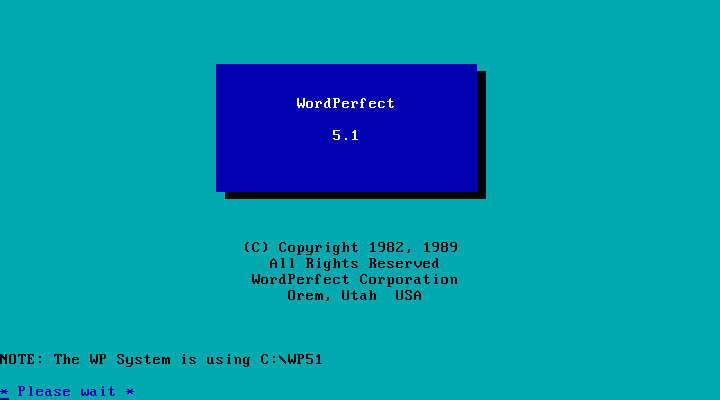
The splash screen for WordPerfect 5.1
The tables feature gave you rudimentary spreadsheet capabilities embedded within your document. These could perform simple arithmetic operations on the contents of cells, and you could even import spreadsheets directly into a WordPerfect file from Microsoft Excel, Lotus 1-2-3 (up to v2.2), and PlanPerfect, or any other spreadsheet that could save in .WK1 format. The spreadsheet could automatically be updated whenever you opened your WordPerfect document.
Also included was support for more than 450 printers.
LetterPerfect and Product Diversification (1990)
In 1990, the company launched a cut-down version of its flagship 5.1 product, called LetterPerfect, selling for $100. This was intended for use on less capable machines such as laptops as well as being an entry-level product for students and home users. It did not support tables, labels, sorting, equation editing, or styles. The same year they launched their non-word processing products: DataPerfect 2.1, DrawPerfect 1.0 and 1.1, and PlanPerfect 5.1.
From 1988 to 1990 WordPerfect Corporation enjoyed its best growth years, with annual sales growing from $198M to over $500M. This was partly due to the shake-out in the word processing software market, which, by the end of the 80s left just Microsoft and WordPerfect still standing. It was also partly due to the diversification of its product line from just the core word processor software market into databases, spreadsheets and more. During this time the company also saw its WordPerfect user base grow from 2 million to 7 million users, and their employee headcount rose from 1,100 to 4,000.
The Windows Era
WordPerfect 5.1 for Windows arrived in Q4 of 1991. It was a dismal failure, being very unstable, had few features over its DOS counterpart, and even used a DOS-based installation program. Version 5.2 for Windows shortly followed as a huge bug-fix release.
WordPerfect Corporation entered 1992 claiming they had an 85% share of the DOS word processing software market. This was true, but Microsoft Word for Windows had a 16-month lead over WordPerfect and was establishing itself as the firm favourite on the Windows operating system with over half the Windows word processing market compared to WordPerfect's one third. This year closed with the first revenue dip from $622M down to $579M.
WordPerfect Enters the Integrated Application Market (1992)
All Works applications have pull-down menus and context-sensitive help, and they are all linked by a customizable "run" menu, letting users switch applications without exiting to the shell menu. Files from the word processing, graphics editor, and spreadsheet applications are fully compatible with WordPerfect's WordPerfect 5.1, DrawPerfect 1.1, and PlanPerfect 5.1." PC Magazine, June 1992
In early 1993, the company strategy was to continue product expansion and competition with Microsoft. An updated version of WordPerfect for Windows launched, which met with more favourable reviews in the press, allowing the company to recoup some of the Windows WP market. The final version released for DOS was WordPerfect 6, released in late 1993. This version was able to switch between the traditional text-based editing mode and a graphical editing mode that showed the document as it would print out, known as WYSIWYG (What You See Is What You Get), including fonts. This year also saw WordPerfect Corp. team up with Borland to produce their first Windows suite including WordPerfect for Windows and Borland Quattro.
The Company is Sold (1994)
1994 came around and the international user base had grown to 15 million. In January Ashton stepped down as president and chief executive in a management restructuring programme designed to get some young blood into the firm. The company launched its "Main Street" line of consumer products as well as WordPerfect InfoCentral 1.0 personal information manager. The company was sold by its two owners who had 49.5% ownership each, in a merger with Novell in 1994 for about $885 million. Coinciding with this Novell-WordPerfect deal, Novell also agreed to acquire Borland for $145 million.
WordPerfect Corporation was known throughout its life for having exceptional product support, with a free customer hotline for anyone who needed advice on how to use its products. This customer support network was also very beneficial to the company to understand what features its users really needed as well as identify any bugs in the software.

In its heyday, WordPerfect Corporation occupied a 7-building 85-acre campus in Orem, Utah.
The Corel Deal (1996)
Novell sold WordPerfect Corporation to Corel in February 1996 for $115 million. In the 22 months since they bought the word processing firm, it continued to lose market share against Microsoft. The original plan of Novell's was to combine its knowledge of networking with the power of WordPerfect's applications in order to compete head-on with Microsoft. Sadly it proved a bad fit. The deal with Corel included the PerfectOffice application suite, WordPerfect word processor, and Quattro Pro spreadsheet. It also meant Novell would buy 20% of Corel's stock. By December of that same year, WordPerfect still led in standalone word processing sales, with 47.9% of the market compared to 44.5% for Microsoft Word. But in the far larger application suite market, Microsoft Office dominated, with 86.5% share compared to just 5.4% for PerfectOffice.
The very last minor DOS version from Corel was 6.2. Bear in mind this was 1997, so Windows 95 had been out for a year, and it had been a whopping 7 years since WordPerfect 5.1.
Corel WordPerfect 6.2's Graphics (WYSIWYG) Mode
All versions of WordPerfect up to v5.0 were written directly in x86 assembly language, as there were no decent C compilers available for the IBM PC during the product's initial creation and port to MS-DOS. The C language was only adopted with WordPerfect 5.1, when it became necessary to cross-port it to non-IBM compatibles. The fact it was written in assembly language however, gave it a distinct advantage - it was much better performing compared to WordStar.
In numerous older versions (up to 4.2) you can execute wp/s (no space) to bring up a setup menu.
